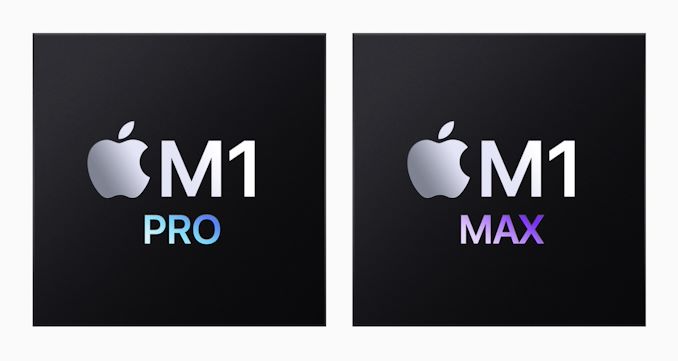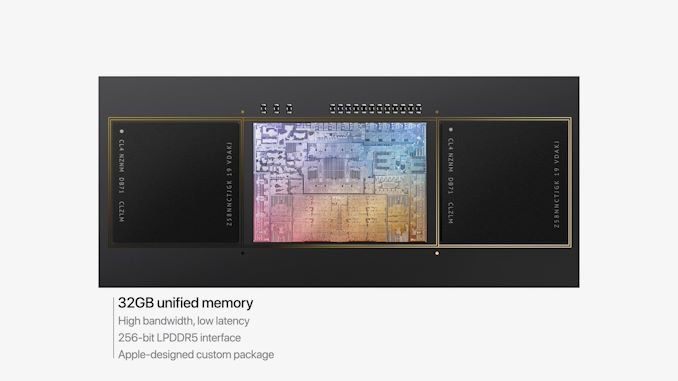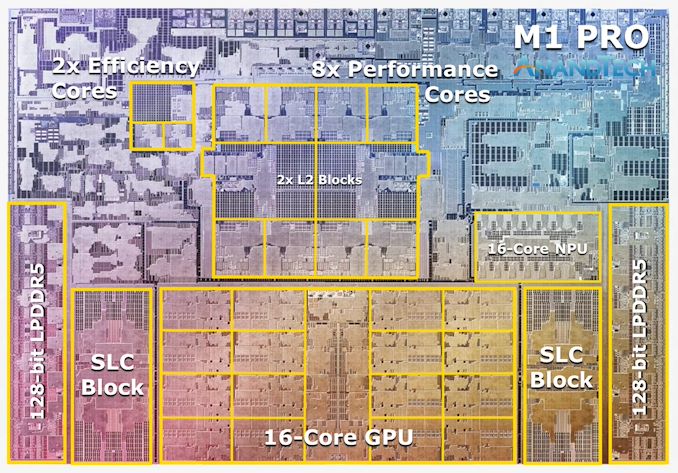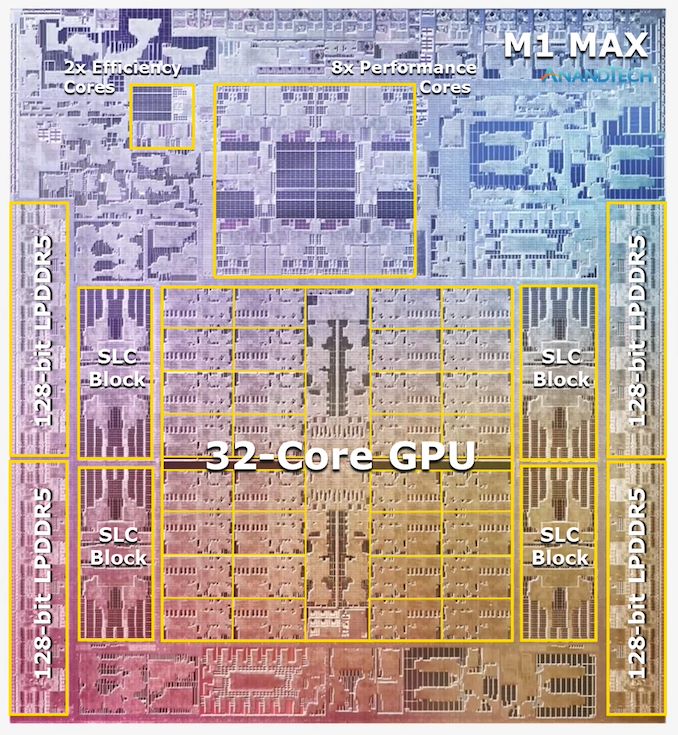Apple's M1 Pro, M1 Max SoCs Investigated: New Performance and Efficiency Heights
by Andrei Frumusanu on October 25, 2021 9:00 AM EST- Posted in
- Laptops
- Apple
- MacBook
- Apple M1 Pro
- Apple M1 Max

Last week, Apple had unveiled their new generation MacBook Pro laptop series, a new range of flagship devices that bring with them significant updates to the company’s professional and power-user oriented user-base. The new devices particularly differentiate themselves in that they’re now powered by two new additional entries in Apple’s own silicon line-up, the M1 Pro and the M1 Max. We’ve covered the initial reveal in last week’s overview article of the two new chips, and today we’re getting the first glimpses of the performance we’re expected to see off the new silicon.
The M1 Pro: 10-core CPU, 16-core GPU, 33.7bn Transistors
Starting off with the M1 Pro, the smaller sibling of the two, the design appears to be a new implementation of the first generation M1 chip, but this time designed from the ground up to scale up larger and to more performance. The M1 Pro in our view is the more interesting of the two designs, as it offers mostly everything that power users will deem generationally important in terms of upgrades.
At the heart of the SoC we find a new 10-core CPU setup, in a 8+2 configuration, with there being 8 performance Firestorm cores and 2 efficiency Icestorm cores. We had indicated in our initial coverage that it appears that Apple’s new M1 Pro and Max chips is using a similar, if not the same generation CPU IP as on the M1, rather than updating things to the newer generation cores that are being used in the A15. We seemingly can confirm this, as we’re seeing no apparent changes in the cores compared to what we’ve discovered on the M1 chips.
The CPU cores clock up to 3228MHz peak, however vary in frequency depending on how many cores are active within a cluster, clocking down to 3132 at 2, and 3036 MHz at 3 and 4 cores active. I say “per cluster”, because the 8 performance cores in the M1 Pro and M1 Max are indeed consisting of two 4-core clusters, both with their own 12MB L2 caches, and each being able to clock their CPUs independently from each other, so it’s actually possible to have four active cores in one cluster at 3036MHz and one active core in the other cluster running at 3.23GHz.
The two E-cores in the system clock at up to 2064MHz, and as opposed to the M1, there’s only two of them this time around, however, Apple still gives them their full 4MB of L2 cache, same as on the M1 and A-derivative chips.
One large feature of both chips is their much-increased memory bandwidth and interfaces – the M1 Pro features 256-bit LPDDR5 memory at 6400MT/s speeds, corresponding to 204GB/s bandwidth. This is significantly higher than the M1 at 68GB/s, and also generally higher than competitor laptop platforms which still rely on 128-bit interfaces.
We’ve been able to identify the “SLC”, or system level cache as we call it, to be falling in at 24MB for the M1 Pro, and 48MB on the M1 Max, a bit smaller than what we initially speculated, but makes sense given the SRAM die area – representing a 50% increase over the per-block SLC on the M1.
The M1 Max: A 32-Core GPU Monstrosity at 57bn Transistors
Above the M1 Pro we have Apple’s second new M1 chip, the M1 Max. The M1 Max is essentially identical to the M1 Pro in terms of architecture and in many of its functional blocks – but what sets the Max apart is that Apple has equipped it with much larger GPU and media encode/decode complexes. Overall, Apple has doubled the number of GPU cores and media blocks, giving the M1 Max virtually twice the GPU and media performance.
The GPU and memory interfaces of the chip are by far the most differentiated aspects of the chip, instead of a 16-core GPU, Apple doubles things up to a 32-core unit. On the M1 Max which we tested for today, the GPU is running at up to 1296MHz - quite fast for what we consider mobile IP, but still significantly slower than what we’ve seen from the conventional PC and console space where GPUs now can run up to around 2.5GHz.
Apple also doubles up on the memory interfaces, using a whopping 512-bit wide LPDDR5 memory subsystem – unheard of in an SoC and even rare amongst historical discrete GPU designs. This gives the chip a massive 408GB/s of bandwidth – how this bandwidth is accessible to the various IP blocks on the chip is one of the things we’ll be investigating today.
The memory controller caches are at 48MB in this chip, allowing for theoretically amplified memory bandwidth for various SoC blocks as well as reducing off-chip DRAM traffic, thus also reducing power and energy usage of the chip.
Apple’s die shot of the M1 Max was a bit weird initially in that we weren’t sure if it actually represents physical reality – especially on the bottom part of the chip we had noted that there appears to be a doubled up NPU – something Apple doesn’t officially disclose. A doubled up media engine makes sense as that’s part of the features of the chip, however until we can get a third-party die shot to confirm that this is indeed how the chip looks like, we’ll refrain from speculating further in this regard.














493 Comments
View All Comments
taligentia - Monday, October 25, 2021 - link
M1 destroyed its competitors in real world use. Performance/battery life was unlike anything we had seen.And companies like Davinci are saying that M1 Pro/Max continue this even further.
So the idea that Apple is just doing this for benchmarks is laughable.
techconc - Monday, October 25, 2021 - link
@goatfajitas Apple has never been caught cheating in benchmarks. You seem to confuse Apple with your typical Android OEM in that regard.Lavkesh - Monday, October 25, 2021 - link
Ignore him. Just a butt hurt troll with nothing else to do.name99 - Monday, October 25, 2021 - link
:eyeroll:schujj07 - Monday, October 25, 2021 - link
Basically the M1 is great in synthetic benchmarks but once you have to run applications it falls behind. Apple made this big deal about how their GPU could compete with the mobile 3080 at 1/3 the power all based on synthetic benchmarks. However, once the GPU is actually used you see it is only 1/3 as fast as the mobile 3080 in real scenarios. I also do not like the use of SPEC at all. It is essentially a synthetic benchmark as well. Problem is there aren't a lot of benchmarks for the Apple eco system that aren't like Geekbench.SarahKerrigan - Monday, October 25, 2021 - link
SPEC isn't a synthetic - it's real workload traces.schujj07 - Monday, October 25, 2021 - link
More like its "real world." OEMs spend hours tweaking their platforms to get the highest SPEC score possible. That really shows how SPEC borders real world and synthetic. I have been to many conferences and never once have the decision makes for companies said they made their decision based on SPEC performance. It is essentially nothing more than a bragging right for OEMs.The Garden Variety - Monday, October 25, 2021 - link
I did some googling and could not find measurements to back up your statements. I'm interested in learning more about how the M1's real performance is dramatically below the measurements of people like Andre, et al. I've relied on Anandtech to provide a sort of quantitative middle ground, and I'm a little rocked to hear that I shouldn't. Could you point me in the right direction for articles or some kind of analysis? You don't have to do my homework for me, just let me know where I could read more.schujj07 - Monday, October 25, 2021 - link
That is the biggest problem with the Apple eco system. Typical benchmark suites aren't useful as many of the programs either don't run on ARM or OSX. Therefore you are left with things like Geekbench or SPEC. I will be interested in seeing what the M1 Max can do in things like Adobe. Puget Systems has their own Adobe Premiere benchmark suite but the M1 Max hasn't been benchmarked, however, the M1 has. https://www.pugetsystems.com/labs/articles/Apple-M...Ppietra - Monday, October 25, 2021 - link
Puget Premiere Pro benchmark is in the article, though I would never classify that as CPU benchmark, nor Premiere Pro as particularly suitable to make general conclusions considering that it isn’t as optimised for macOS as it is for Windows.